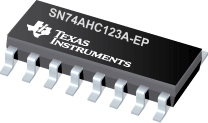

SN74AHC123A-EP是TI公司的一款单稳多频振荡器产品,SN74AHC123A-EP是SN54AHC123A-EP, SN74AHC123A-EP,本页介绍了SN74AHC123A-EP的产品说明、应用、特性等,并给出了与SN74AHC123A-EP相关的TI元器件型号供参考。
SN74AHC123A-EP - SN54AHC123A-EP, SN74AHC123A-EP - 单稳多频振荡器 - 特殊逻辑 - TI公司(Texas Instruments,德州仪器)
- Controlled Baseline
- One Assembly Site
- One Test Site
- One Fabrication Site
- Extended Temperature Performance of -55°C to 125°C
- Enhanced Diminishing Manufacturing Sources (DMS) Support
- Enhanced Product-Change Notification
- Qualification Pedigree(1)
- Operating Range 2-V to 5.5-V VCC
- Schmitt-Trigger Circuitry On A, B, and CLR Inputs for Slow Input Transition Rates
- Edge Triggered From Active-High or Active-Low Gated Logic Inputs
- Retriggerable for Long Output Pulses
- Overriding Clear Terminates Output Pulse
- Glitch-Free Power-Up Reset On Outputs
- Latch-Up Performance Exceeds 100 mA Per JESD 78, Class II
- ESD Protection Exceeds JESD 22
- 2000-V Human-Body Model (A114-A)
- 200-V Machine Model (A115-A)
- 1000-V Charged-Device Model (C101)
(1) Component qualification in accordance with JEDEC and industry standards to ensure reliable operation over an extended temperature range. This includes, but is not limited to, Highly Accelerated Stress Test (HAST) or biased 85/85, temperature cycle, autoclave or unbiased HAST, electromigration, bond intermetallic life, and mold compound life. Such qualification testing should not be viewed as justifying use of this component beyond specified performance and environmental limits.
DESCRIPTION/ORDERING INFORMATION
The SN74AHC123A device is a dual retriggerable monostable multivibrator designed for 2-V to 5.5-V VCC operation.
This edge-triggered multivibrator features output pulse-duration control by three methods. In the first method, the A input is low, and the B input goes high. In the second method, the B input is high, and the A input goes low. In the third method, the A input is low, the B input is high, and the clear (CLR) input goes high.
The output pulse duration is programmed by selecting external resistance and capacitance values. The external timing capacitor must be connected between Cext and Rext/Cext (positive) and an external resistor connected between Rext/Cext and VCC. To obtain variable pulse durations, connect an external variable resistance between Rext/Cext and VCC. The output pulse duration can be reduced by taking CLR low.
Pulse triggering occurs at a particular voltage level and is not directly related to the transition time of the input pulse. The A, B, and CLR inputs have Schmitt triggers with sufficient hysteresis to handle slow input transition rates with jitter-free triggering at the outputs.
Once triggered, the basic pulse duration can be extended by retriggering the gated low-level-active (A) or high-level-active (B) input. Pulse duration can be reduced by taking CLR low. CLR can be used to override A or B inputs. The input/output timing diagram illustrates pulse control by retriggering the inputs and early clearing.
The variance in output pulse duration from device to device is less than ±0.5% (typ) for given external timing components.
During power up, Q outputs are in the low state and Q outputs are in the high state. The outputs are glitch free, without applying a reset pulse.
For additional application information on multivibrators, see the application report Designing With the SN74AHC123A and SN74AHCT123A, literature number SCLA014.








